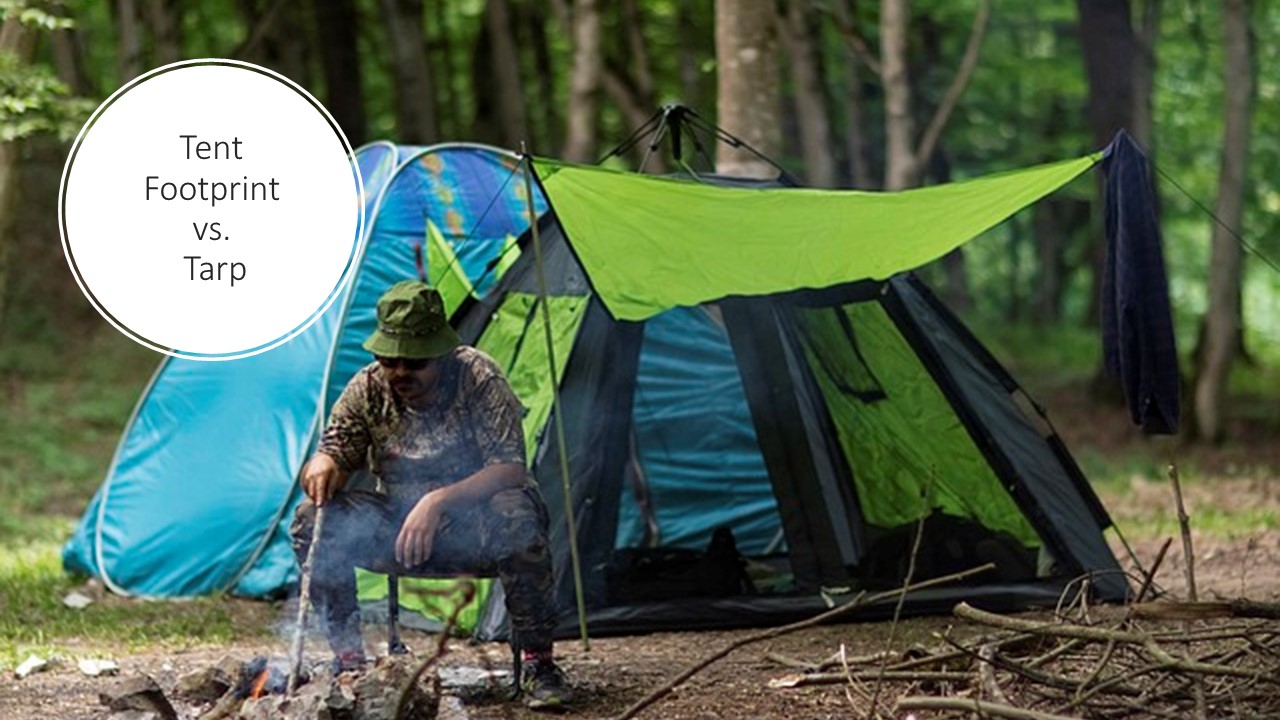Hey there fellow outdoor enthusiasts! Planning your next camping adventure and want to ensure your tent stays protected and dry? Well, you’ve come to the right place. Today, we’re going to dive into the age-old debate of tent footprints vs. tarps as ground covers. As an avid camper myself, I understand the importance of choosing the right gear to make your camping experience comfortable and worry-free. So, let’s settle in, grab a cup of coffee, and explore the pros and cons of both options, so you can make an informed decision that suits your needs. Trust me, by the end of this article, you’ll have a clear understanding of whether a tent footprint or a tarp is your camping companion of choice. Let’s get started!
Understanding Tent Footprints
Let’s dive into the world of tent footprints and uncover what they are all about.
A tent footprint is a protective ground cloth specifically designed to go underneath your tent. It acts as a barrier between the tent floor and the ground, providing an additional layer of protection. Tent footprints are typically made of durable materials like nylon or polyethylene and come in various sizes to match different tent models.
The primary purpose of a tent footprint is to safeguard your tent from potential damage caused by sharp objects, rocks, moisture, or rough terrain. By placing a footprint beneath your tent, you create a buffer zone that helps prolong the life of your tent and keeps it in better condition over time.
Benefits of Using a Tent Footprint
Using a tent footprint brings a range of advantages to your camping experience. Let’s explore some of the key benefits:
- Increased durability and longevity of your tent: By providing an extra layer of protection, a tent footprint helps prevent abrasion and punctures, reducing the chances of wear and tear on your tent floor. This ultimately extends the lifespan of your tent, saving you money in the long run.
- Enhanced insulation against cold or damp ground: Tent footprints often have insulating properties, helping to keep you warmer and more comfortable inside the tent. They create a barrier between the tent floor and the potentially cold or damp ground, providing an extra level of insulation during chilly nights or in damp environments.
- Prevention of moisture seepage: Moisture can seep into your tent from the ground, especially during rainy conditions or in areas with high humidity. A tent footprint acts as a waterproof layer, keeping moisture at bay and helping to maintain a dry and comfortable interior.
- Easier cleaning and maintenance: Tent footprints are designed to be easily cleaned and dried. They can be wiped clean or hosed off if they get dirty, saving you the hassle of having to clean the entire tent. Additionally, they can be folded compactly and stored separately from your tent, keeping everything organized.
Choosing the Right Tent Footprint
When selecting a tent footprint, there are a few factors to consider to ensure the best fit for your tent and camping needs.
- Size: Choose a tent footprint that matches the dimensions of your tent’s floor. It should be slightly smaller than the tent’s footprint to prevent rainwater from collecting between the footprint and the tent.
- Material: Look for a tent footprint made of durable and waterproof materials, such as ripstop nylon or polyethylene. These materials offer excellent resistance to wear, tear, and moisture.
- Weight and packability: If you’re concerned about weight and packability, opt for lightweight and compact tent footprints that won’t add unnecessary bulk to your camping gear.
- Compatibility with your tent: Some tent manufacturers offer footprints specifically designed for their tent models. While not always necessary, using a footprint designed for your tent can ensure a perfect fit and optimal protection.
Take your time to research and choose a tent footprint that aligns with your tent model, camping style, and the conditions you’re likely to encounter.
With a tent footprint in place, you can enjoy peace of mind knowing that your tent is better protected from the elements and potential damage.
In the next section, I’ll explore an alternative to tent footprints – tarps – and see how they compare in terms of ground cover options. Stay tuned.
Exploring Tarps as Ground Covers
Let’s take a closer look at why tarps are worth considering for your camping adventures.
Tarps, short for tarpaulins, are large, waterproof sheets typically made of durable materials like polyethylene or nylon. They come in various sizes and are known for their multi-purpose functionality. While their primary use is often for shelter and protection from the elements, they can also be used as effective ground covers.
Pros and Cons of Using Tarps
Using a tarp as a ground cover has its own set of advantages and considerations. Let’s examine both sides of the coin:
Pros:
- Cost-effectiveness: Tarps are generally more affordable compared to dedicated tent footprints, making them a budget-friendly option for campers.
- Multi-purpose functionality: Beyond serving as a ground cover, tarps can be used for additional shelter, as an extra layer of rain protection, or even as a makeshift picnic or seating area.
- Availability and variety: Tarps are readily available at most outdoor stores, hardware stores, or online retailers. They come in various sizes, colors, and thicknesses, providing options to suit your specific needs.
Cons:
- Added weight and bulk: Compared to specialized tent footprints, tarps can be bulkier and heavier to carry, especially if you opt for larger sizes. This can be a consideration if you prioritize lightweight and minimalist camping gear.
- Limited insulation: Tarps, while providing a barrier between your tent and the ground, may not offer the same level of insulation as tent footprints designed specifically for that purpose. This can be a factor to consider if you’ll be camping in colder or damper conditions.
- Increased condensation: Tarps, due to their waterproof nature, can trap moisture between the tarp and the ground, leading to potential condensation issues. Adequate ventilation becomes crucial to mitigate this concern.
Selecting the Ideal Tarp:
If you decide to go with a tarp as your ground cover, here are a few factors to consider when choosing the right one for your camping needs.
- Durable materials suitable for camping: Look for tarps made of high-quality, tear-resistant materials like polyethylene or nylon. Reinforced edges and grommets can enhance their longevity and provide secure attachment options.
- Size considerations and attachment options: Determine the appropriate size that matches the dimensions of your tent or the area you want to cover. Ensure the tarp has sufficient grommets or loops for easy attachment and securing.
- DIY tarp modifications for better tent coverage: You can get creative and make custom modifications to your tarp, such as cutting it to fit the exact shape of your tent or adding additional grommets for a more secure fit.
Remember, while tarps can be a versatile and cost-effective choice for a ground cover, they may not offer the same level of insulation and convenience as tent footprints. Consider the specific conditions of your camping trip and your personal preferences before making a final decision.
Now that I’ve explored the world of tarps as ground covers, it’s time to compare them to tent footprints. Stay tuned for the next section, where I’ll delve into the benefits of using tent footprints and help you make an informed choice.
Tent Footprint vs. Tarp: A Comparative Analysis
Now comes the moment of truth – the comparative analysis between tent footprints and tarps as ground covers. Let’s dive into the key factors and see how these two options stack up against each other.
1. Protection and Durability:
When it comes to protecting your tent and ensuring its longevity, both tent footprints and tarps have their strengths:
- Tent Footprints: Tent footprints are specifically designed to fit the dimensions of your tent’s floor. They offer excellent protection against moisture, rocks, and other ground-level hazards. Made from durable materials, such as ruggedized nylon or polyethylene, tent footprints are built to withstand wear and tear.
- Tarps: While tarps may not offer the tailored fit of tent footprints, they still provide a protective barrier between your tent and the ground. They can shield your tent from moisture and rough terrain, but their level of durability may vary depending on the material and quality of the tarp.
2. Insulation and Comfort
Camping should be comfortable, regardless of the weather conditions. Here’s how tent footprints and tarps fare in terms of insulation:
- Tent Footprints: Tent footprints often have added insulation features, such as a waterproof coating or a thermal reflective layer, which help keep the tent floor warmer and drier. This can be particularly beneficial in colder or damper environments.
- Tarps: While tarps do provide a layer of protection, they may not offer the same level of insulation as tent footprints. Their primary purpose is to create a barrier between your tent and the ground, but they might not provide as much insulation against cold or damp conditions.
3. Weight and Portability
If you’re an avid backpacker or concerned about keeping your camping gear lightweight, the weight and portability of your ground cover matter. Let’s see how tent footprints and tarps compare:
- Tent Footprints: Tent footprints are designed with portability in mind. They are often lightweight and compact, fitting easily into your backpack or gear storage. This makes them a great option for backpacking or trips where every ounce counts.
- Tarps: Tarps, on the other hand, tend to be bulkier and heavier than tent footprints, especially if you opt for larger sizes. If you’re looking to minimize weight and maximize space, tarps may not be the most ideal choice for ultralight camping.
4. Ease of Setup and Maintenance
Setting up camp should be a breeze, and maintaining your gear should be hassle-free. Let’s examine the setup and maintenance considerations for both options:
- Tent Footprints: Tent footprints are typically designed to match the shape and size of your tent. This means they are easy to lay out and attach, providing a seamless setup process. Additionally, tent footprints are relatively low maintenance, requiring minimal cleaning and care.
- Tarps: Setting up a tarp as a ground cover might involve a bit more creativity and flexibility, as they come in various sizes and shapes. You’ll need to ensure proper placement and secure attachment points. Tarps may require more maintenance, as they can accumulate dirt and debris that need to be cleaned off.
5. Cost and Value for Money
Budget considerations often come into play when choosing camping gear. Let’s see how tent footprints and tarps compare in terms of cost and value:
- Tent Footprints: Tent footprints, being specialized camping accessories, tend to have a higher price point compared to tarps. However, their durability and added features make them a worthwhile investment for avid campers who prioritize long-term use and protection for their tents.
- Tarps: Tarps are generally more affordable compared to tent footprints, making them an attractive option for campers on a budget or occasional campers who may not require the same level of specialized protection. They offer a cost-effective solution without compromising basic ground cover needs.
In the end, the choice between tent footprints and tarps as ground covers boils down to your specific camping needs, preferences, and budget. Consider the level of protection, insulation, weight, setup convenience, and cost that aligns with your camping style.
I’ve covered the comparative analysis, but don’t pack up just yet! In the next section, I’ll wrap things up and provide a comprehensive conclusion to help you make a well-informed decision. Stay tuned!
Conclusion:
And that’s a wrap! I’ve explored the world of tent footprints and tarps as ground covers, comparing their features, advantages, and considerations. Now, it’s time to make a final decision based on your individual camping needs and preferences.
If you prioritize tailored protection, durability, and enhanced insulation, tent footprints may be the way to go. They are specifically designed to fit your tent, offering reliable defense against moisture, rocks, and wear and tear. Tent footprints provide peace of mind and can prolong the life of your tent, especially in challenging camping conditions.
On the other hand, if you’re seeking a budget-friendly option with versatility and multi-purpose functionality, tarps can be a solid choice. They offer a barrier between your tent and the ground, protecting against moisture and rough terrain. While they may not provide the same level of insulation as tent footprints, they are readily available, affordable, and can serve various purposes beyond ground cover.
Consider your camping style, the specific conditions you’ll encounter, and your budget when making your decision. Remember, there is no one-size-fits-all answer. It ultimately comes down to what works best for you and your camping adventures.
No matter which option you choose, proper setup and maintenance are key to ensuring the longevity of your gear. Take the time to secure your ground cover properly and keep it clean and free from debris.
I hope this article has provided you with valuable insights and helped you navigate the tent footprint vs. tarp dilemma. May your future camping trips be filled with comfort, adventure, and unforgettable moments in the great outdoors.
Happy camping, my fellow outdoor enthusiasts!







